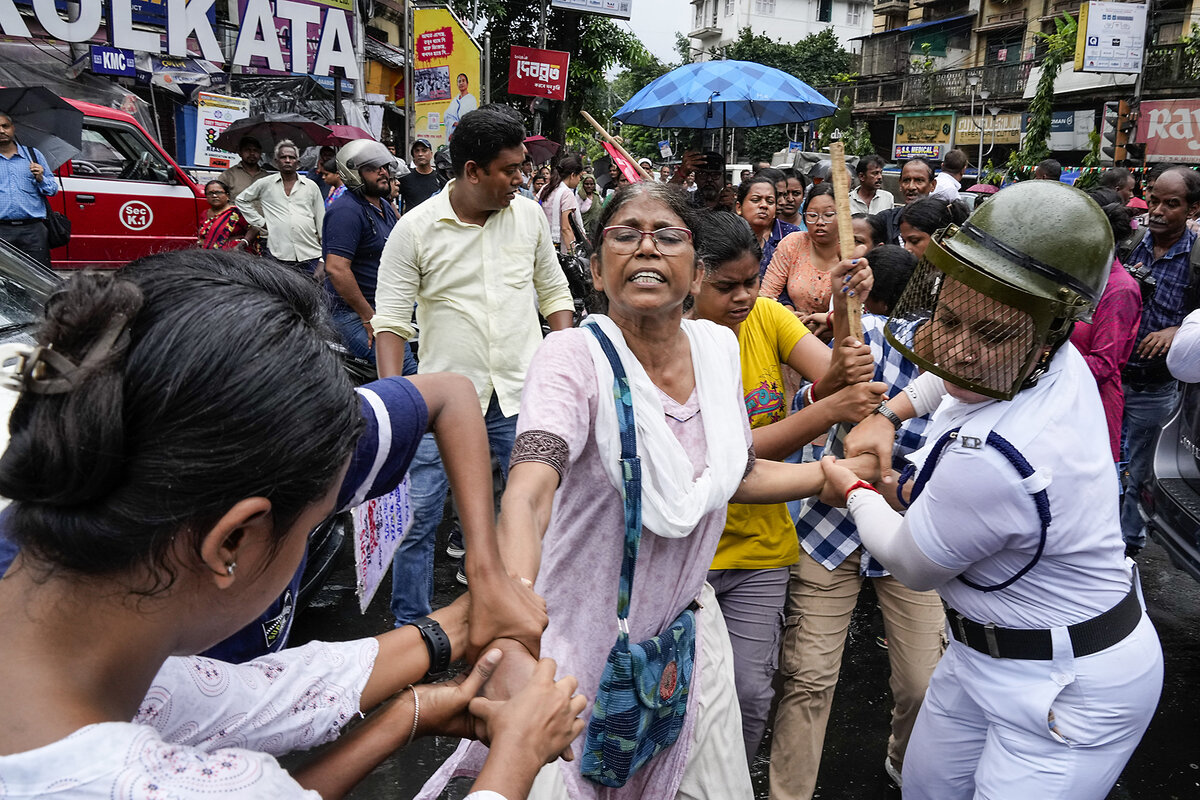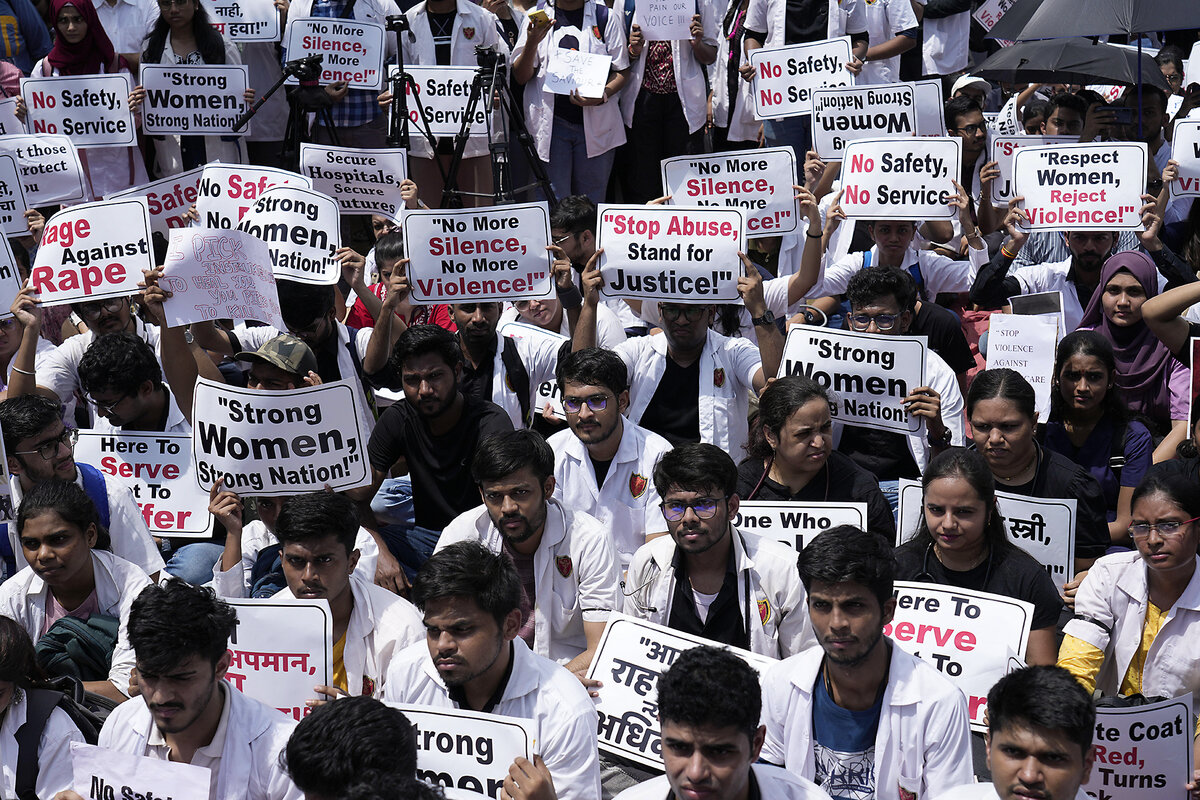Protests over women’s safety in India are taking cues from an unusual source
Loading...
| Kolkata, India
For University of Calcutta senior Sanhita Sarkar, there was little to celebrate on India’s recent Independence Day.
The brutal rape and killing of a trainee doctor at the state-run R.G. Kar Hospital in Kolkata had sparked mass protests throughout the city, and as she joined thousands of other women carrying signs and blazing torches that evening, Ms. Sarkar wondered: Will the women of India ever truly be free?
The “Reclaim the Night” march was a call for justice and systemic change in a country that has long struggled to control rampant violence against women. It is a call that has echoed across India in the week since.
Why We Wrote This
A story focused onIndia has long struggled to tackle gender-based violence. But as Kolkata reels from a brutal attack on a young doctor, some protesters point to neighboring Bangladesh as proof that with enough solidarity, change is possible.
Protesters in Mumbai, Delhi, and other cities are demanding a transparent investigation and improved safety measures at government hospitals, as well as expressing frustration at the lack of progress on women’s safety. Doctors have gone on strike, refusing to treat nonemergency patients. On Tuesday, India’s Supreme Court established a task force to address hospital safety, but many say it’s not enough.
And back where it all started – in the state of West Bengal – protests continue to grow, with organizers drawing inspiration from neighboring Bangladesh. Across the border, student protests over a controversial job quota system ballooned into a broader movement against the government’s autocratic tendencies, successfully ousting the country’s long-ruling prime minister earlier this month.
Ms. Sarkar says that she felt the need to “imbibe the courage of the common people of Bangladesh” when she marched on Aug. 15.
“The youth of Bangladesh joined hands to go against the unfair treatments of their government and ... snatched away what they deserved – freedom,” she says. “The hope, the unity, the faith that Bangladesh showed simply gives more strength and power to the citizens of West Bengal.”
The Kolkata protests are unlike anything the state has ever witnessed, says Sreyasi Chatterjee Banerjee, a sociology professor specializing in gender at Prasanta Chandra Mahalanobis Mahavidyalaya, a college in Kolkata.
What began as targeted demonstrations among medical staff and students, primarily over hospital safety, have expanded to encompass many sectors of society – similar to the Bangladesh protests, which spread after security officials killed unarmed student protesters.
Now, the head of West Bengal’s government, Chief Minister Mamata Banerjee (of no relation to the professor), is under intense scrutiny for mistakes allegedly made by her administration and Kolkata police early on in the R.G. Kar case, including failing to secure the crime scene, initially downplaying the victim’s death as a suicide, and cracking down on student protests. Many are calling for her to step down.
In a viral video this week, one of Ms. Banerjee’s ministers was heard pushing back on her critics, vowing that “we will never allow West Bengal to turn into another Bangladesh.”
Bangladesh comparisons aside, this isn’t the first time India has erupted over violence against women.
The 2012 gang rape of a young woman on a New Delhi bus sparked nationwide protests, and prompted Indian authorities to introduce stricter anti-rape laws. Yet activists and gender-based violence experts say that when it comes to the safety of women and other gender minorities, India hasn’t moved the needle much.
“If we go by the book, then a lot has changed since 2012,” says Professor Banerjee. “But in reality, the general public are not sensitized enough, and know little about the modifications of the anti-rape laws.”
That lack of awareness was underscored by a wave of social media users encouraging people to share the R.G. Kar doctor’s name and photograph – an activity that may may not be malicious but violates Section 228A of the Indian Penal Code, which forbids revealing a rape victim’s identity.
“They are revealing every tiniest detail” about the case, she says.
Indeed, some activists say that if the last 12 years have revealed anything, it’s how deeply ingrained gender-based violence is in Indian society.
According to the National Crime Records Bureau in India, an average of 86 rapes per day were reported nationwide in 2022, the most recent year for which data is available. Given the stigma around reporting rape, the actual number of attacks is believed to be much higher.
“Each and every girl I know has been molested in her life at least once,” says Kolkata-based lawyer Shafqat Rahim, who participated in the Aug. 15 “Reclaim the Night” protest and other demonstrations. “This has been normalized in this male-dominated society. We are fighting against ... a culture which promotes rape.”
But the Bangladesh protests have inspired many in Kolkata to believe that change is possible, even in the face of biased laws or unfair systems. Their success “is one of the reasons why many of the students [in Kolkata] who [previously] considered themselves apolitical are also participating in this movement,” Ms. Rahim says.
That inspiration flows both ways. In Bangladesh’s capital, Dhaka, students returned to the streets last week, with young women at the forefront, to march in solidarity with Kolkata.
“The issue of the R.G. Kar rape and murder resonates deeply with us,” says Tasneem Zaman Labeeb, a Dhaka University student. “For years, we have witnessed the brutalities inflicted on women in Bangladesh and observed how the state often acts to protect the perpetrators. The parallels in how the state apparatus covers up one crime, leading to a cascading effect, are strikingly similar.”








